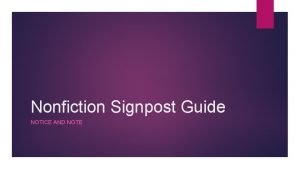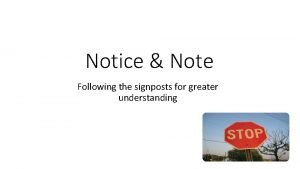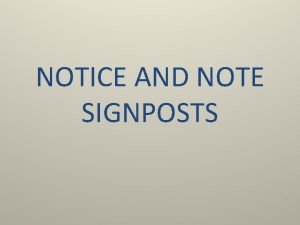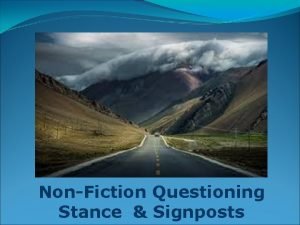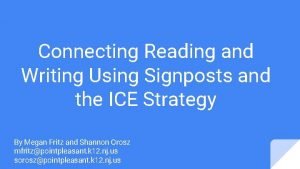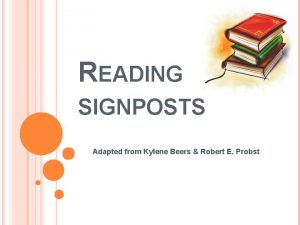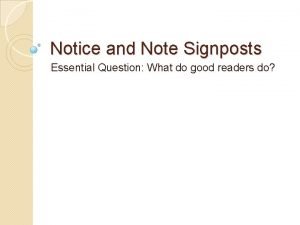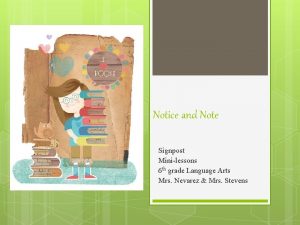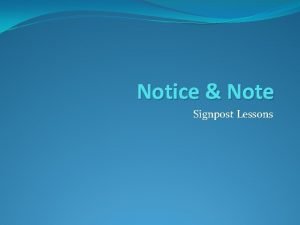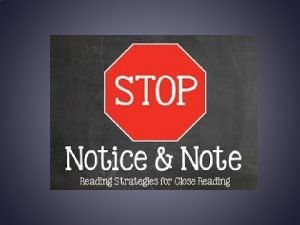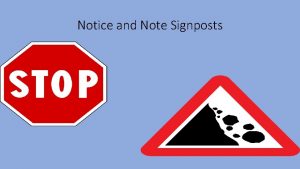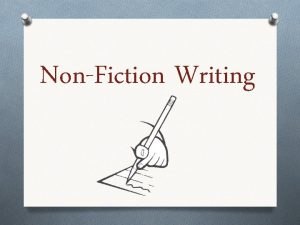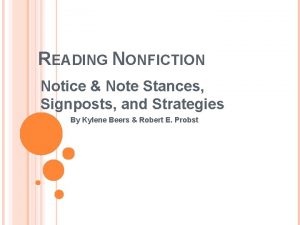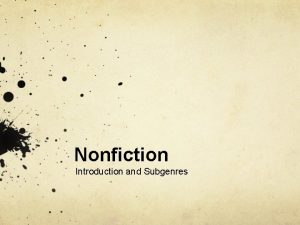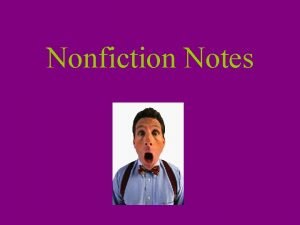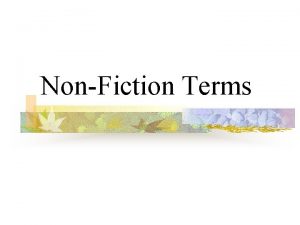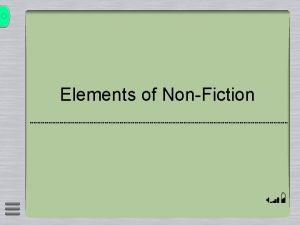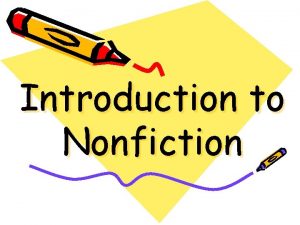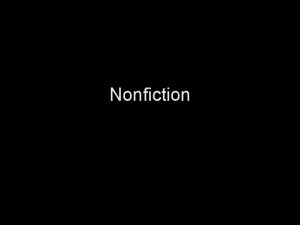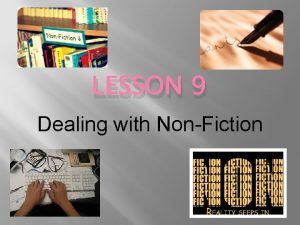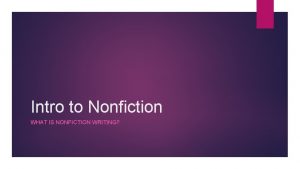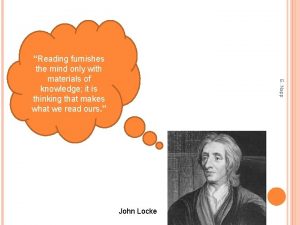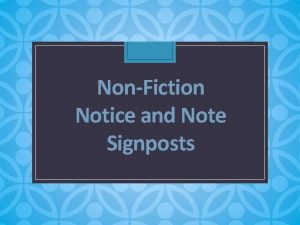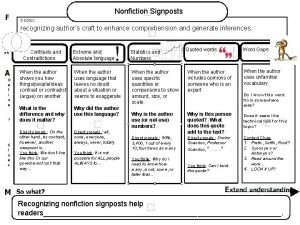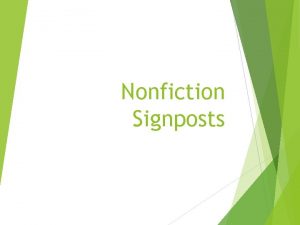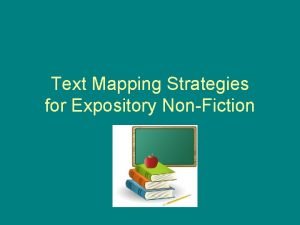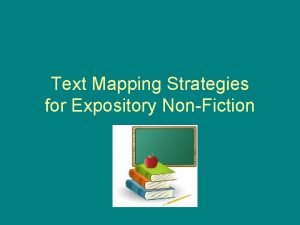Nonfiction Reading Strategies Signposts and Activities Reading furnishes






















- Slides: 22

Nonfiction Reading Strategies Signposts and Activities “Reading furnishes our mind only with materials of knowledge; it is thinking that makes what we read ours. ” - John Locke

�In her book Reading Like a Writer, Francine Prose speaks to the importance of close reading: “I read closely, word by word, sentence by sentence, pondering each deceptively minor decision the writer had made. ” (2006, 3). We embrace close reading as a way to focus students’ attention on the craft of writing.

Close Reading � A key to close reading is pace. We need to slow students down as they read and provide a focus that helps them see and appreciate each choice a writer makes. � We (Harvey and Goudvis) embrace Tom Newkirk’s definition of slow reading as “the relationship we have with what we read, with the quality of attention that we bring to our reading, with the investment we are willing to make. ” � Newkirk calls on us as readers to “commit ourselves to follow a train of thought, to mentally construct characters, to follow the unfolding of an idea, to hear a text, to attend to language, to question, to visualize scenes” (2012, 2). To instill this habit of slowing down as readers requires practice and focused attention on the writer’s craft.

�Debbie Miller says, “We must teach our students what nonfiction is. is Teaching our students that expository text has predictable characteristics and features they can count on before they read allows them to construct meaning more easily as they read” (qtd. in Harvey and Goudvis 108).

Notes on Nonfiction: Its Makeup �Nonfiction books are organized around specific topics and main ideas �Nonfiction books give you information that is true. �Nonfiction books try to teach you something. �When readers read nonfiction books they make predictions about the kinds of things they expect to learn. They activate their schema and the topic and what they know about the type of text they are about to read. �Nonfiction books have features.

Nonfiction Signposts-The Original �Comparisons & �Valuable Visuals Contrasts �When the author uses graphic features like charts, diagrams, graphs and pictures to convey information ask: �How does the graphic help the reader understand or connect the information? comparisons like analogies, similes and metaphors to simplify concepts ask: �How does this comparison help the reader understand?

Nonfiction Signposts-The Original �Comparisons & Contrasts �When the author uses comparisons like analogies, similes and metaphors to simplify concepts ask: �How does this comparison help the reader understand? “Acts of personal vengeance reflect a biologically rooted sense of justice, they say, that functions in the brain something like appetite. ” (“Payback Time: Why Revenge Tastes to Sweet” )

Nonfiction Signposts-The Original �Valuable Visuals �When the author uses graphic features like charts, diagrams, graphs and pictures to convey information ask: �How does the graphic help the reader understand or connect the information?

Nonfiction Signposts-The Original �Definitions & �Words from the Wise Descriptions �When the author uses �When the author quotes from experts to support the claims or evidence ask: �How does the expert’s quote enhance the author’s information? defines a word or describes a concept ask: �Why did the author want the reader to know that word or concept?

Nonfiction Signposts-The Original � ''We've shown many times that expressing anger often escalates and leads to more aggression, '' said Dr. Brad Bushman, a psychologist at the University of Michigan who conducted the study, ''but people express it for the same reason they eat chocolate. '' (“Payback Time: Why revenge Tastes So Sweet”) �Words from the Wise �When the author uses quotes from experts to support the claims or evidence ask: �How does the expert’s quote enhance the author’s information?

Nonfiction Signposts-The Original � Victim impact statements, where � Definitions & Descriptions �When the author defines a word or describes a concept ask: �Why did the author want the reader to know that word or concept? victims are allowed to describe their ordeal and offer input on an offender's sentencing, have become common in U. S. , Australian and Finnish courts. (Revenge and the people who seek it”) � This kind of payback is closer to what sociologists and philosophers call just-deserts retribution. Dr. John M. Darley, a professor of psychology and public affairs at Princeton University, said such actions involve a deliberate effort to tailor the retribution to the crime, often taking into consideration as many relevant details about the

Nonfiction Signposts-The Original �Evidence & Examples �Main Idea �When the author uses �When the author facts and examples to support the main idea ask: �Which facts are most important to support the main idea? presents the “big idea” of a passage- what it’s all about ask: �How does the author support the main idea?

Nonfiction Signposts-The Original � Recent research has �Evidence & Examples �When the author uses facts and examples to support the main idea ask: �Which facts are most important to support the main idea? shown that stable communities depend on people who have ''an intrinsic taste for punishing others who violate a community's norms, '' said Dr. Joseph Henrich, an anthropologist at Emory University in Atlanta. (“Payback Time: Why Revenge Tastes So Sweet”)

Nonfiction Signposts-The Original �Revenge is like an appetite that cannot be satisfied until there is closure. �Main Idea �When the author presents the “big idea” of a passage- what it’s all about ask: �How does the author support the main idea?

Nonfiction Signposts-Revised � 1) Extreme or absolute language � 2) An alike moment � 3) Experts & Amateurs � 4) Stats & Numbers The last two signposts are unchanged from the fiction signposts. � 5) Contrasts & Contradictions � 6) Again & Again

Nonfiction Signposts-Revised � 1) Extreme or absolute language �does the author use language like “everybody”, or insinuate something is definitely going to happen? Students should learn to question this. � 2) An alike moment �when the author tries to show something is like something else to help the reader understand � 3) Experts & Amateurs �readers should look at what gives that person the right say something (critically evaluating quotations and authors expertise). � 4) Stats & Numbers �help the reader visualize � 5) Contrasts & Contradictions �The writer says something that is contradictory or contrasts with what is expected or reveals a difference that is not expected. � 6) Again & Again �A word/phrase or argument or opinion occurs repeatedly.

Some Strategies

FQR Chart: Fact-Question. Response � The strategy emphasis supports students to ask questions, determine importance in the text, and respond, voicing their own opinions and thoughts. � Eventually students will be able to use this response method independently to read for information in text they have chosen at their own reading level. � Students record factual information, ask questions, and respond to merge their thinking with the content. � When students have the opportunity to share and explain their own thinking about text, they learn and remember important information

FQR Chart: Fact-Question. Response Example: “The Comeback of Humpbacks” National Geographic for Kids (Sept 2000) Facts Question Leaping out of the water Is all jumping called is called breaching? Response 30 x more than in 1965 WOW! That is a lot. That was a good comeback. I don’t like the hunters using only one part of the whale. Reminds me of the white men wasting the buffalo. Humpbacks were almost gone until a law was created to protect humpbacks

Reading a Textbook Don’t read front to back (aka, READ BACKWARDS) � Reading a textbook chapter front to back ensures that you will waste time. � I know it’s counter-intuitive to not read a book front to back, but don’t do it. Mystery novels stink when you read the back first, as do good thriller movies. If you read the last page of a Sherlock Holmes novel before you read the story, it’ll be lame. � But textbooks are rarely building to a suspenseful twist at the end. I promise. � I’ve read a lot. They don’t come with surprise endings. “And then, Abraham Lincoln dodged the bullet!” Yep, that’s never

Reading a Textbook Want to try this strategy? Try reading your textbook chapter in this order: � 1. Go to the questions at the end first. �Read them, answer them to the best of your ability, and then begin your actual reading strategies. This will sort of “prime the engine” of retention. � 2. Next, read the final summary of the chapter. �This will give you a general background as to the Big Ideas in the chapter. � 3. Third, look at the headings and subdivision of the chapter. � 4. Fourth, read the chapter introduction. �From that point you can then work through the chapter from front to back. By taking this out-of-order strategy, you are focusing not on the chronological order, but rather

Works Cited �Beers, Kylene and Bob Probst. Notice and Note Presentation. Minneapolis, MN. October 2014. �Harvey, Stephanie and Anne Goudvis. (2007). Strategies that work: Teaching comprehension for understanding and engagement (2 nd ed. ). Portland, ME: Stenhouse Publishers.
 Lime furnishes the plant food element
Lime furnishes the plant food element Contrast and contradiction examples
Contrast and contradiction examples Pre reading while reading and post reading activities
Pre reading while reading and post reading activities Reading stance
Reading stance Notice and note signposts examples
Notice and note signposts examples Notice and note signposts
Notice and note signposts Word gaps signpost
Word gaps signpost Signposts in reading examples
Signposts in reading examples What are the six signposts
What are the six signposts Indoor sports and outdoor sports
Indoor sports and outdoor sports Primary and support activities
Primary and support activities Definition of primary activities
Definition of primary activities Nonfiction reading test black friday
Nonfiction reading test black friday Signposts notice and note
Signposts notice and note Signposts language arts
Signposts language arts Signpost notes
Signpost notes Stop notice and note signposts
Stop notice and note signposts Listening
Listening The statement of cash flows helps users
The statement of cash flows helps users What are signposts
What are signposts Signposts ela
Signposts ela Notice and note strategies
Notice and note strategies Types of readings
Types of readings

